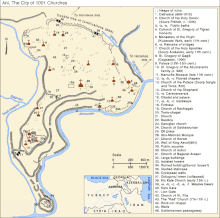Siege of Ani (1124)
| Siege of Ani | |||||||||
|---|---|---|---|---|---|---|---|---|---|
 Plan of Ani | |||||||||
| |||||||||
| Belligerents | |||||||||
| | Shaddadids | ||||||||
| Commanders and leaders | |||||||||
| David IV | Abu'l-Aswar Shavur ibn Manuchihr | ||||||||
| Strength | |||||||||
| 60,000 | Unknown | ||||||||
The Siege of Ani (Georgian: ანისის ალყა) took place in 1124, which the Georgian army under the command of David IV the Builder liberated the ancient capital of Armenia, the city of Ani, and the northern Armenia from the Muslim emirs.[1]
History
[edit]Ani had been in Muslim hands since its capture by Alp Arslan in 1064 and a forced Islamization of the city had taken place since the sale of Ani to the Shaddadids, to the discontent of the local Christian population.[2]
The city of Ani was an important economic center of the Near East, during this period it was owned by Abu'l-Aswar Shavur ibn Manuchihr, who succeeded his father Manuchihr ibn Shavur in 1118.[3] Abu'l-Aswar was accused by the contemporary Armenian historian Vardan Areveltsi of persecuting Christians and attempting to sell Ani to the Seljuk emir of Kars,[4] he also placed a crescent on the dome of the Cathedral of Ani.[5][6]
In response, Ani's Armenians appealed to King David IV to capture Ani,[5][7] taking this opportunity in hand, David IV summoned all his armies and entered Armenia with 60,000 men to take the city. Without a single fight, the Armenian population of Ani opened the gates to the Georgians,[8] who captured emir Abu'l-Aswar Shavur ibn Manuchihr and exiled him and his family to Abkhazia, Samuel Anetsi notes that "not a single soul was harmed by blood". The region was then left to the governance of the Meskhetian nobility, to General Abuleti and his son Ivane.[9]
Armenian families (including many dispossessed nobles[10]) subsequently established themselves in Georgia proper and the royal power built the city of Gori for them.[11] Northern Armenia was thus annexed and incorporated into the Kingdom of Georgia, increasing the power of David IV in the region.[12] Georgia's conquest of Northeast Armenia finally completed the ultimate project of securing South Caucasus against the Turkish threat. For the first time, the entire Caucasus is unified culturally, spiritually and politically under a single scepter, this being Georgia.[13]
King David IV freed the Cathedral of Ani, after which the cathedral returned to Christian usage.[5][14] Katranide, the queen of the Greeks who built the Cathedral, was buried there. David, together with the Catholicos and the bishops, took care of the deceased and called the tomb three times "Rejoice, you holy queen, for God has saved your throne from the hands of the unrighteous."[12]
References
[edit]- ^ Pubblici 2022, p. 20.
- ^ René Grousset (1947). Histoire de l'Arménie des origines à 1071. Paris: Payot. p. 615. ISBN 978-2-228-88912-4..
- ^ Metreveli 2011, p. 113.
- ^ Peacock 2011.
- ^ a b c Hasratyan 2002.
- ^ "The Cathedral of Ani". virtualani.org. Virtual Ani. Archived from the original on 7 April 2016.
- ^ "The Cathedral of Ani". virtualani.org. Virtual Ani. Archived from the original on 7 April 2016.
- ^ Asatiani & Bendianashvili 1997, p. 125.
- ^ Minorsky 1953, pp. 84–85.
- ^ Bedrosian 1997, p. 251.
- ^ Sempad the Constable. Chronicle
- ^ a b Metreveli 2011, p. 114.
- ^ Asatiani & Janelidze 2009, pp. 86–87.
- ^ "The Cathedral of Ani". virtualani.org. Virtual Ani. Archived from the original on 7 April 2016.
Bibliography
[edit]- Hasratyan, Murad (2002). "Անիի Մայր Տաճար (Cathedral of Ani)". In Ayvazyan, Hovhannes (ed.). "Քրիստոնյա Հայաստան" հանրագիտարան ("Christian Armenia" Encyclopedia) (in Armenian). Armenian Encyclopedia Publishing. pp. 63–64.
- Pubblici, Lorenzo (2022). Mongol Caucasia: Invasions, Conquest, and Government of a Frontier Region in Thirteenth-Century Eurasia (1204-1295). Brill.
- Metreveli, Roin (2011). Saint David the Builder. Tbilisi. ISBN 9789941425509.
{{cite book}}: CS1 maint: location missing publisher (link)[permanent dead link] - Peacock, Andrew (2011). "Shaddadids". Encyclopædia Iranica.


 French
French Deutsch
Deutsch